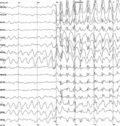An event-related potential (ERP) is the measured brain response that is the direct result of a specific sensory, cognitive, or motor event. More formally...
29 KB (3,532 words) - 02:48, 2 June 2025
thought of as evoked potentials, though they do meet the above definition. Evoked potential is different from event-related potential (ERP), although the...
42 KB (5,224 words) - 07:18, 14 March 2025
P300 (neuroscience) (redirect from Event-related potentials, p300)
wave is an event-related potential (ERP) component elicited in the process of decision making. It is considered to be an endogenous potential, as its occurrence...
21 KB (2,546 words) - 07:26, 14 March 2025
Bereitschaftspotential (redirect from Movement related potential)
by the primary motor area, MI[citation needed]. A very similar event-related potential (ERP) component had earlier been discovered by the British neurophysiologist...
23 KB (2,971 words) - 21:10, 4 May 2025
Early left anterior negativity (redirect from ELAN (event-related potential))
left anterior negativity (commonly referred to as ELAN) is an event-related potential in electroencephalography (EEG), or component of brain activity...
13 KB (1,501 words) - 23:13, 3 January 2024
Error-related negativity (ERN), sometimes referred to as the Ne, is a component of an event-related potential (ERP). ERPs are electrical activity in the...
42 KB (5,093 words) - 18:26, 22 May 2025
related to a host of self- evaluative processes. Event-related potentials (ERPs) can measure autonoetic consciousness scientifically. Event-related brain...
15 KB (1,734 words) - 19:05, 30 November 2023
particularly with the P300 wave and P3a component of the OR-related event-related potential (ERP). Current understanding of the localization of OR in the...
8 KB (978 words) - 12:56, 11 January 2022
In neuroscience, the lateralized readiness potential (LRP) is an event-related brain potential, or increase in electrical activity at the surface of the...
28 KB (4,234 words) - 14:12, 25 May 2025
processing in regard to most event-related potentials; however, they do display significant differences in event related potential responses involved with...
32 KB (3,618 words) - 00:47, 24 May 2025
P50 (neuroscience) (category Evoked potentials)
In electroencephalography, the P50 is an event related potential occurring approximately 50 ms after the presentation of a stimulus, usually an auditory...
5 KB (545 words) - 07:23, 14 March 2025
non-invasive technique used to measure sensory gating, a type of event-related potential. For normal sensory gating, if a person hears a pair of clicks...
13 KB (1,666 words) - 15:46, 28 May 2025
N400 (neuroscience) (category Evoked potentials)
The N400 is a component of time-locked EEG signals known as event-related potentials (ERP). It is a negative-going deflection that peaks around 400 milliseconds...
24 KB (3,099 words) - 20:46, 19 March 2025
language comprehension. The N400 was the first language-relevant event-related potential to be identified, and since its discovery EEG and MEG have become...
53 KB (5,700 words) - 18:46, 21 October 2024
that unit is actually encountered. Evidence from eyetracking, event-related potentials, and other experimental methods indicates that in addition to integrating...
19 KB (2,594 words) - 14:15, 31 July 2023
from event-related potential signals figuring out the spatial profile of individual face recognition For the experiment, conventional event-related potential...
122 KB (14,546 words) - 23:04, 22 May 2025
functioning of the brain during the learning process, such as event-related potential and functional magnetic resonance imaging, are used in educational...
52 KB (6,594 words) - 19:16, 17 May 2025
Global catastrophic risk (redirect from Potential threats to humanity)
hypothetical event that could damage human well-being on a global scale, endangering or even destroying modern civilization. Existential risk is a related term...
53 KB (5,661 words) - 07:45, 3 June 2025
Contingent negative variation (category Evoked potentials)
and an imperative ("go") stimulus. The CNV was one of the first event-related potential (ERP) components to be described. The CNV component was first described...
16 KB (2,228 words) - 03:49, 28 March 2025
C1 and P1 (category Evoked potentials)
(also called the P100) are two human scalp-recorded event-related brain potential (event-related potential (ERP)) components, collected by means of a technique...
24 KB (3,554 words) - 02:39, 31 May 2024
auditory stimulus evokes responses measured in the form of an event-related potential (ERP), measured brain responses resulting directly from a thought...
46 KB (6,051 words) - 13:20, 9 February 2025
processing. These event-related potentials are measured brain responses to specific stimuli, such as sensory, cognitive or motor events. ERPs, when compared...
16 KB (2,239 words) - 02:32, 3 April 2025
P3b (category Evoked potentials)
The P3b is a subcomponent of the P300, an event-related potential (ERP) component that can be observed in human scalp recordings of brain electrical activity...
44 KB (5,893 words) - 19:49, 3 December 2023
equal to the equilibrium potential of that ion. When Vm is at the reversal potential for an event such as a synaptic potential (Vm − Erev is equal to 0)...
8 KB (868 words) - 18:13, 21 April 2025
in response to neural events associated with behavioral trials. According to D'Esposito, "event-related fMRI has the potential to address a number of...
10 KB (1,352 words) - 01:41, 19 July 2022
the effects of centrally acting drugs on arousal and memory: an event-related potential study of scopolamine, lorazepam and diphenhydramine". Psychopharmacology...
60 KB (5,242 words) - 12:51, 27 May 2025
a stimulus of some sort (visual, somatosensory, or auditory). Event-related potentials (ERPs) refer to averaged EEG responses that are time-locked to...
133 KB (15,926 words) - 19:52, 3 June 2025
Late positive component (category Evoked potentials)
component or late positive complex (LPC) is a positive-going event-related brain potential (ERP) component that has been important in studies of explicit...
21 KB (2,670 words) - 08:50, 16 January 2025
Lie detection (section Event-related potentials (ERP))
be tested in forensic practice. See also cognitive biometrics. Event-related potentials assess recognition, and therefore may or may not be effective in...
40 KB (5,171 words) - 04:55, 25 May 2025
neurological causes of SPD. Electroencephalography (EEG), measuring event-related potential (ERP), and magnetoencephalography (MEG) are traditionally used...
57 KB (5,767 words) - 16:12, 22 May 2025









